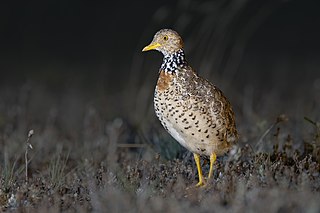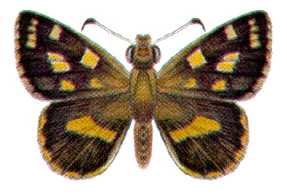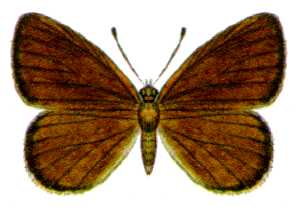
The plains-wanderer is a bird, the only representative of family Pedionomidae and genus Pedionomus. It is endemic to Australia. Its historic range included much of eastern Australia, including Victoria, New South Wales, South Australia and the Northern Territory, but in recent years it has become endangered with remaining known populations concentrated in the Riverina region of New South Wales and western Queensland.
Australians generally assumed in the 1850s that railways would be built by the private sector. Private companies built railways in the then colonies of Victoria, opened in 1854, and New South Wales, where the company was taken over by the government before completion in 1855, due to bankruptcy. South Australia's railways were government owned from the beginning, including a horse-drawn line opened in 1854 and a steam-powered line opened in 1856. In Victoria, the private railways were soon found not to be financially viable, and existing rail networks and their expansion were taken over by the colony. Government ownership also enabled railways to be built to promote development, even if not apparently viable in strictly financial terms. The railway systems spread from the colonial capitals, except for a few lines that hauled commodities to a rural port.

The bush rat or Australian bush rat is a small Australian nocturnal animal. It is an omnivore and one of the most common indigenous species of rat on the continent, found in many heathland areas of Victoria and New South Wales.

The yellow-footed antechinus, also known as the mardo, is a shrew-like marsupial found in Australia. One notable feature of the species is its sexual behavior. The male yellow-footed antechinus engages in such frenzied mating that its immune system becomes compromised, resulting in stress related death before it is one year old.
Sword grass may refer to:
The following lists events that happened during 1861 in Australia.
The following lists events that happened during 1862 in Australia.
The following lists events that happened during 1863 in Australia.

Tisiphone is a genus of butterflies of the subfamily Satyrinae in the family Nymphalidae. The genus was erected by Jacob Hübner in 1819.

Hesperilla crypsargyra, also known as the silvered skipper or silver hedge-skipper, is a species of butterfly in the family Hesperiidae. It is found in the Australian states of New South Wales, Queensland and Victoria.

Hesperilla idothea, commonly known as the flame sedge-skipper, is a species of butterfly in the family Hesperiidae. It is found in the Australian states of New South Wales, Queensland, South Australia and Victoria.

Candalides heathi, the rayed blue, is a species of butterfly of the family Lycaenidae. It is found in southern Australia, including South Australia, New South Wales and Victoria.

Candalides hyacinthina, the varied dusky-blue, is a species of butterfly of the family Lycaenidae. It is found along the east coast of Australia, including South Australia, New South Wales, Western Australia and Victoria.

Gahnia sieberiana, commonly known as the red-fruit saw-sedge, is a tussock-forming perennial plant in the family Cyperaceae, endemic to Australia. It is a widespread plant that favours damp sunny sites. Many insect larvae have been recorded feeding on the red-fruit saw-sedge. It may grow over 2 metres tall.
The Bravery Council of Australia Meeting 77 Honours List was announced by the Governor General of Australia on 27 August 2012.

Ogyris olane, the Olane azure, is a butterfly in the family Lycaenidae. It is found in Australia, where it is found in most of the eastern half, including Queensland, New South Wales, Victoria and South Australia.

Hypochrysops delicia, the moonlight jewel, is a member of the family Lycaenidae. It is found in eastern Australia.
The Bravery Council of Australia Meeting 82 Honours List was announced by the Governor General of Australia on 30 March 2015.
The Special Honours Lists for Australia are announced by the Sovereign and Governor–General at any time.
This page is based on this
Wikipedia article Text is available under the
CC BY-SA 4.0 license; additional terms may apply.
Images, videos and audio are available under their respective licenses.












